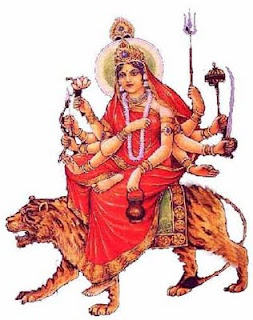
|| Chandraghanta ||
Mantra to chant:
"Om sarva mangal mangalye shive sarvarath sadhike,Sharanye triambake gauri narayani namostute."
Chandraghanta devi sits on a tiger, and radiates a golden hue. She manifests ten hands and three eyes. Eight hands display weapons while the remaining two are giving blessings and protection. Special benediction: bliss, knowledge, peace and serenity, growtrh of all activities, purpose of life. She is worshiped in this form in Kanchipuram (Tamil Nadu) India. We see expansion of red energies with pink lightning flashes going directly to the spinal column to strengthen to all activities, activate root chakra (mooladhara); activating birth/growth of new activities; opening of the heart chakra begins. Semicircular spiral energies of navy blue create movement in the spiritual and material zone for all auspicious, karma-freeing work. As you pray and meditate, there will be a feeling of satisfaction as all solar plexus chakras are being freed from greed. Beautiful droplets of nectar are replacing the poison as the uncoiling serpents are sucking it away.o Offering: Three bananas in the morning, light a candle morning-evening, accept and share banana prasadam with others. Mentally offer all fragrant flowers, fruits, gems, clothing. Send all the negative thoughts to the center of the earth, as all energy today will bring power to the lower limbs. Remember to offer something to mother earth – milk, money, water, fertilizer.
Third Day Of Navratri Dedicated To Chandraghanta Devi Devi Chandraghanta Ma Is Known As ChandraKhand. Wallpaper of Goddess maa chandraghanta, Maa Chandraghanta, Chandraghanta Devi, Chandraghanta Mantra – Chandraghanta Navadurga-Third form of Maa Durga Worshiped on 3rd day Navratri-10th oct 2011
Chandraghanta devi sits on a tiger, and radiates a golden hue. She manifests ten hands and three eyes. Eight hands display weapons while the remaining two are giving blessings and protection. Special benediction: bliss, knowledge, peace and serenity, growtrh of all activities, purpose of life. She is worshiped in this form in Kanchipuram (Tamil Nadu) India. We see expansion of red energies with pink lightning flashes going directly to the spinal column to strengthen to all activities, activate root chakra (mooladhara); activating birth/growth of new activities; opening of the heart chakra begins. Semicircular spiral energies of navy blue create movement in the spiritual and material zone for all auspicious, karma-freeing work. As you pray and meditate, there will be a feeling of satisfaction as all solar plexus chakras are being freed from greed. Beautiful droplets of nectar are replacing the poison as the uncoiling serpents are sucking it away.o Offering: Three bananas in the morning, light a candle morning-evening, accept and share banana prasadam with others. Mentally offer all fragrant flowers, fruits, gems, clothing. Send all the negative thoughts to the center of the earth, as all energy today will bring power to the lower limbs. Remember to offer something to mother earth – milk, money, water, fertilizer.
Third Day Of Navratri Dedicated To Chandraghanta Devi Devi Chandraghanta Ma Is Known As ChandraKhand. Wallpaper of Goddess maa chandraghanta, Maa Chandraghanta, Chandraghanta Devi, Chandraghanta Mantra – Chandraghanta Navadurga-Third form of Maa Durga Worshiped on 3rd day Navratri-10th oct 2011
 Goddess Brahmacharini Mata - Second Navadurga
Goddess Brahmacharini Mata - Second Navadurga


